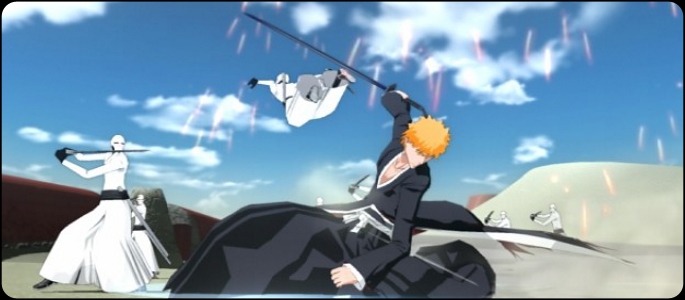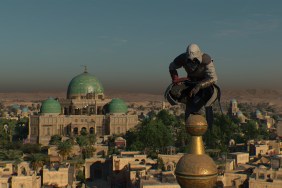The Bleach anime series has kept on going strong since 2004, with the manga originally coming out in 2001, and in that time there have been a over 20 games released over various platforms. The latest one is Soul Resurreccion, or Soul Ignition as it is known in Japan. With a wealth of content to pull from and extremely likeable characters, can Bleach: Soul Resurreccion reach the same level of polish as another anime styled video game, Naruto: Ultimate Ninja Storm?
In Soul Resurreccion, Ichigo Kurosaki, his friends, and the Soul Reapers of the 13th Court Guard must defeat the traitor Sosuke Aizen and his army of Arrancars. Aizen and his group threatening the very peace of the Soul Society and human world. For those who have never paid attention to this series, then forget about even attempting to understand much of the story; you will be lost. Luckily, there is absolutely no need to understand what you are doing and why, as the game does very little to go in detail about it. In fact, the only real story you get is from walls of text displayed before episodes and a bit of squabbling between characters at a boss fight. It is actually a wonder they even had any story element in the game because as it is, what is there is completely worthless and un-needed.
The game is broken down into three different modes: Story, Mission, and Soul Attack. The story mode of the game will see you playing through fourteen extremely short episodes. I played the game on normal difficulty through my first play through and never died, completed the mode in around 3 hours, and never had any issues. Sadly, even when bumped up to hard, things still are fairly easy, though the boss fights do ramp up just a tick. Each episode is played with a different character, though Ichigo stars in a few of them naturally.
Added to the shortness of each episode is the extremely bland, boring, and repetitive environments. There are around 3 different settings recycled throughout the entire game, ranging from a gray desert to a war-torn city, and these never do much to impress. Thankfully, the combat, while hack-n-slash in the vein of Dynasty Warriors, is not too generic and moves are full of lots of life. The game offers you 21 playable characters, but only 18 are unlocked through playing the story mode. Each character has a very unique set of attacks and special moves that are vibrant and fun to pull off. Chain together enough attacks to build up your Ignition game, allowing you to perform your ultimate attack. All of these moves can be mixed together in a smooth and fluid combat system that provides enough fun to offset some of the length issues. It really is sad though to see such fun combat ruined by short episodes and some of the most boring environments around.
Once you’re done with the Story Mode, you can move on to a 28-stage Mission Mode. I would suggest completing the story as most of the missions are only unlocked after completing certain episodes. These missions have a difficulty level that’s different to the game’s normal difficulty level, with them having their own unique set of clear conditions. One mission might have you defeating 100 Soul Reapers, while another will force you to beat a boss without dashing or using Ignition. You can also select any character you wish for any mission, and there are 3 more characters to unlock in this mode. Mission mode will introduce some new enemies but these are merely older enemies colored differently.
A leveling system is used throughout all modes of the game, these Soul Points are found throughout levels in both story and mission mode, either from fallen enemies or the environment. You can then take these points and apply them to a Final Fantasy type leveling system, where you can use the points to buy unlock nodes on a grid that improve health, spirit pressure, attack, and more. With this, you have some leeway as to how you want to build and level up your character, but you never really see much of a difference other than bigger health bars, because you don’t actually learn new attack moves.
Finally the game offers a Soul Attack mode, which is an online mode featuring leaderboards for six exclusive missions. Again, like the rest of the modes, online suffers from the same lack of variety and ugly landscapes. Sure, there are more bosses and enemies online, but there is really no need to play it unless you like bragging rights.
On the presentation side of things, if you leave out the absolutely mediocre looking environments, the characters of the game and the attacks are all top-notch. High amounts of detail have been added to the characters to properly portray their anime counterparts, and special moves feel very… well special. Audio is very good, with the option to select between English and Japanese voice tracks, but at times audio can get a bit stale, especially when you do a move over and over.
In conclusion, Bleach: Soul Resurreccion is a game that, while technically sound, doesn’t have near enough content to draw in the average player. Add in the fact that there are really only 3 environments in the game and it can be beaten in under 4 hours, and you have a recipe for a perfect weekend rental. Those who enjoy the anime or manga will love playing as their favorite characters and destroying everything in their path, however, the people unfamiliar with the series or those who want more depth to their hack-n-slash will want to steer clear of Soul Society this time around.
PlayStation LifeStyle’s Final Score
– All Three Modes are Far too Similar and Repetitive + Character Models and Special Moves are Stunning |
 |
–








